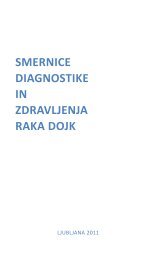You also want an ePaper? Increase the reach of your titles
YUMPU automatically turns print PDFs into web optimized ePapers that Google loves.
Increasement of tumor oxygenation with topical<br />
application of benzyl nicotinate<br />
Zrinka Abramovi} 1 , Marjeta [entjurc 1 , Julijana Kristl 2 , Nadeem Khan 3 ,<br />
Huagang Hou 3 , Harold M. Swartz 3<br />
1<br />
»Jo`ef Stefan« Institute, Jamova 39, 1000 Ljubljana, Slovenija; 2 University of Ljubljana,<br />
Faculty of Pharmacy, A{ker~eva 7, 1000 Ljubljana, Slovenija; 3 EPR Center for the study of<br />
Viable Systems, Department of Diagnostic Radiology, Dartmouth Medical School, Hanover,<br />
03755, NH, USA<br />
Tumor oxygenation is essential parameter that can influence the outcome of radioand<br />
chemotherapy in cancer treatment. The ability to follow the time-course of<br />
tumor pO 2<br />
(partial pressure of oxygen) levels over the longer period of therapy<br />
and finding new approaches to improve tumor oxygenation could therefore help to<br />
optimize cancer therapy. In this study we tested a hypothesis that topical application<br />
of vasodilators, which increase blood flow and consequently partial pressure of<br />
oxygen (pO 2<br />
) in skin and immediately underlying tissues, could be efficient way<br />
to increase oxygenation of superficial tumor in skin with the ultimate goal to use<br />
this approach in combination with radiotherapy. We have investigated the effect of<br />
vasodilator benzyl nicotinate (BN), applied to the surface of the tumor in two drug<br />
delivery systems: hydrogel and microemulsion on the oxygenation of subcutaneously<br />
grown RIF-1 tumors by EPR oximetry in vivo.<br />
RIF-1 tumors were grown subcutaneously in mice. When tumors reached appropriate<br />
volume (100 mm 3 ) an oxygen sensitive paramagnetic probe lithium phthalocyanine<br />
was implanted superficially into peripheral region of the tumors. For the next 5<br />
days a preparation of 2.5% BN in hydrogel or microemlsion was applied on the skin<br />
surface over the tumor and pO<br />
72p1<br />
2<br />
was measured for 60 minutes.<br />
It was found that BN applied topically on the tumor surface in microemulsion and<br />
hydrogel increased tumor pO 2<br />
above the baseline values. As a control microemulsion<br />
or hydrogel without BN was applied on the tumor skin but no change in pO 2<br />
was<br />
observed. The efficacies of the two delivery systems on the action of BN were<br />
compared in order to find optimal formulation, which would enable the best<br />
penetration of vasodilator drug into the skin and consequently maximal increase in<br />
tumor oxygenation. Two different parameters were used to evaluate the effect of<br />
BN: t max<br />
– the time required for the maximal pO 2<br />
increase, and ΔpO 2max<br />
– the maximal<br />
relative increase of pO 2<br />
with respect to the baseline oxygen concentration.<br />
Our results show an increase in tumor oxygenation after topical application of BN in<br />
both delivery systems. Microemulsions were found to be more convenient delivery<br />
system than hydrogel. The observed increase in tumor oxygenation could potentially<br />
lead to an increase in the effectiveness of radiotherapy of hypoxic tumors. This will<br />
be tested in our future work where the efficacy of radiation therapy when irradiation<br />
is done at times of maximal increase in tumor oxygenation after topical application<br />
of BN will be determined.

















